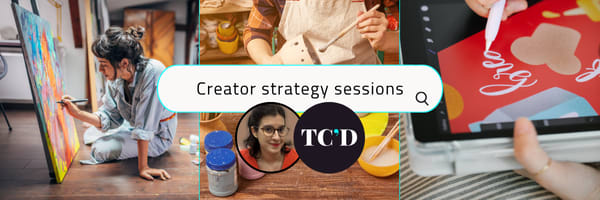Leverage storytelling and the familiarity effect on social media
Learn a valuable method for engaging potential customers on social media.

Hi! 👋
This week, I'll share a valuable method for engaging potential customers on social media.
Welcome (back)! 🤗
This is Petra from The Creators' Diary. If this is your first TC’D newsletter, welcome! We’re happy you’ve subscribed!
Share what you think about this issue or the questions you struggle with as a creator by simply replying to this email. A real human (Petra) reads it.
Story of the week 🗞️
Sharing a product post on social media announcing a new artwork and urging people to visit your webshop is a missed opportunity.
Instead, you could focus on pulling people to your art by sharing a story they can relate to. Simply sharing a sentence or two with that image can be perfectly effective if it gives the right context.
Share your work on social media like this
Whenever you're about to post an artwork on your social media, answer one of these questions and put the answer in your caption:
- Was your artwork born on a particularly hard day for you?
- Was it something you almost gave up on?
- Does it remind you of a dear family member?
- Did it turn out completely different from planned, but somehow even better?
- Is there a song that inspired this artwork?
- Is it connected to a childhood memory?
- What famous person would love this artwork?
... and any similar question can work, too, which allows you to tell a quick story. The point is that this way, you'll humanise what you do and make your product more relatable for potential customers.
In the sea of other posts with images, links, and call-to-actions urging people to visit a website, I can guarantee you that people will remember that bunny ceramics you made in memory of your childhood rabbit 🐰—and that becomes one more lasting impression that you made on someone, even if they don't buy it right on the spot.
The familiarity effect in psychology + impressions in marketing
Impressions are critical for marketing success. An instant buy is a special beast anyway, especially in "everyday" art. Many studies have proven that customers need to encounter your brand and products several times before they make a purchase.
In psychology, this is called the familiarity effect: we are more likely to favour familiar things over unfamiliar things, and often due to repeated exposure. To leverage this effect in marketing, your goal should be to build an emotional connection with your audience and make sure that they repeatedly encounter your work.
Example 👇
Let’s say you’re a potential customer who is also a mother. Would you go and buy from a creator because I showed you a picture of a nice mug they made that, at first glance, might look like any other?
Or would you be more interested in it if I pointed out that the flowers on the mug represent the many roles of a mother in life, and the way mothers constantly bloom for others as caretakers? 💮
What if I tell you that the creator is also a mother?
I think you know which situation is more likely to end with a purchase eventually, especially if you keep up posting like this, focusing on storytelling.
For context, I'm not saying that a "pure" product image and a product name in a post can't be successful at generating sales, and it's understandable if sometimes that's all you have time and energy for. My advice for you is to try the above method, too, and sprinkle in those stories whenever you can. I think you'll see a difference over time, whether in customer engagement or sales numbers.
Creator quote of the week 📌
Here's a good example of what I've described above from ceramicist @Kness:
See you next week,
Petra






